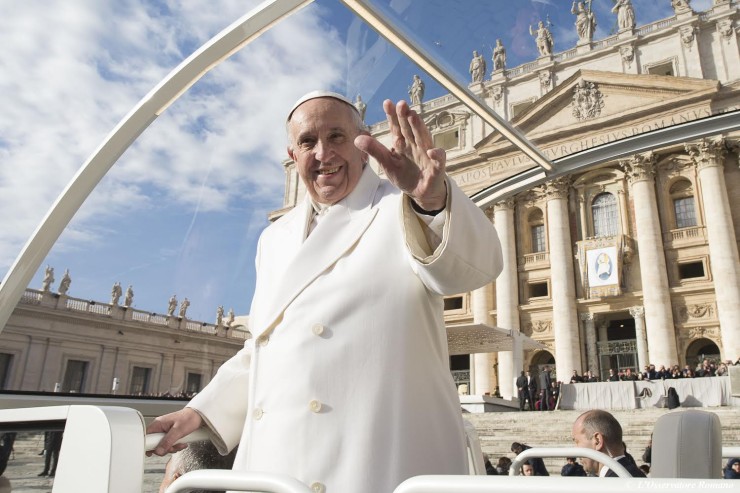Happy Feast of St. Joseph, the Worker
May 1 was also the day on which communist countries celebrated the worker. The two celebrations, at least in this country, have precisely nothing in common except the date. Why? Because the Catholic Church allied itself with organized labor in the late nineteenth century and both served as bulwarks against any communist encroachments into the labor movement. Those who, like Rush Limbaugh and Sean Hannity, think there is a binary choice between being pro-laissez faire and being a Marxist may not know of the historic relationship between the Church and organized labor, but that is just one more thing that they do not know.
This morning, the Holy Father sent out a tweet that read: “I ask everyone with political responsibility to remember two things: human dignity and the common good.” I can think of no two organizations that have done more to advance human dignity and the common good than the Catholic Church and organized labor. Who pushed for workers’ compensation plans and an end to child labor during the Progressive era at the first decades of the twentieth century? Who pushed for what we now know as Social Security and for a forty-hour work week? Who supported a minimum wage? Who backed workplace safety efforts to protect workers’ from unsafe working conditions? The Church and labor.
Look at Washington today. The city is teeming with special interest groups, some of whom hold positions I support, others which hold positions I abhor, but very few of which even think about the common good. But, there is organized labor, standing for the rights of workers who do not belong to their unions, and for the rights of immigrants who do not belong to any union, and for universal health care for all, not just for union members. (On this last point, shame on the Obama administration for bending over backwards not to offend NARAL and Planned Parenthood while failing to protect the Taft-Hartley insurance plans that organized labor has had for more than fifty years.) And, on all these issues – minimum wage, workers’ rights, immigration reform, the Church has stood with labor, advocating for the rights of those who might not be Catholic but whose human dignity would be enhanced by these reforms. The bishops got it wrong in opposing the Affordable Care Act, for reasons I have explained before and need not revisit today. But, let us note that even in the midst of this brouhaha over the contraception mandate, the bishops have never once advocated repealing the ACA.
Monday, the pope sent out a tweet that said, “Inequality is the root of social evil.” Who has more consistently spoken out against the growing income inequality in this country more than the Church and organized labor? The Second Vatican Council, Pope Paul VI, Pope John Paul II, Pope Benedict XVI and Pope Francis have all, in different ways, warned against the social dangers of income inequality, the need to prioritize the needs of the poor, and the moral and political dangers associated with unrestricted wealth accumulation by the very few. Indeed, we could go back to Pope Leo XIII and Pope Pius XI who were as harsh in their condemnation of laissez-faire capitalism as they were in their condemnation of socialism. And, organized labor has done more advocacy work than anyone on the need to address income inequality, not just at the theoretical level, but by organizing workers to defend their right to the fruits of their labor.
In the past twenty years or so, there has been an effort by some prelates of the Catholic Church to focus the Church’s public attention exclusively on the issues of abortion, opposition to same sex marriage, and now, religious liberty. To be clear, I support the Church’s teachings on abortion, traditional marriage and religious liberty. But, by focusing only on these issues – I say “focusing” but someone who wears white said “obsessing” – the Church has come to resemble a wing of the Republican Party. The only way forward is to follow Pope Francis’ lead and return the Church’s social teachings to the front-burner of our public witness.
There are signs of hope. The bishops’ Mass at the border in Nogales was a clear indication that the Church cares about the immigrants and the need for comprehensive immigration reform. Fr. Clete Kiley continues his work training labor priests - a new generation of Karl Maldens! – who will be positioned to help their parishioners become aware of the Church’s teaching on the dignity of workers and the necessity of organizing to achieve their rights and defend their dignity. If the workers do not come together to vindicate their rights, the powerful will always be able to have their way with the weak. Organized labor is a great challenge to the powerful for just that reason, and we need priests who will tell their people that the Church is always, in obedience to Christ, prepared to stand with the weak against the powerful. And, next month, the Institute for Policy Research & Catholic Studies at Catholic University, where I am a visiting fellow, will host a conference, “Erroneous Autonomy: The Catholic Case Against Libertarianism,” and organized labor has been both supportive of, and very interested in, this conference, resolved to join hands with Catholics to challenge this insidious heresy of libertarianism.
More must be done and it is in the interests of both the Church and organized labor to find ways to work together. Most obviously, the future of both organizations will be spoken and written in Spanish, a fact that places both organized labor and the Catholic Church ahead of the societal and demographic curve. Indeed, the influx of new immigrants has brought new life to both labor and the Church: You do not have to spend much time in Latin America to realize that solidarity is what characterizes their ethos, not any Randian vision of human autonomy. Many of the union locals began in the basement of a church in the late nineteenth and early twentieth century. Our churches must again become a safe haven where workers can come together, out of the sight of management, to organize themselves. And, our nations’ bishops need to follow Pope Francis’ lead and place concern for human dignity in all its ramifications, the unborn as well as the undocumented, the unemployed as well as the uninsured, at the forefront of our public witness. I would point out in this regard that organized labor is the only part of the left-liberal political coalition that has never signed on to Roe v. Wade. The Church and organized labor must follow the Pope’s lead and make the phrase “common good” a phrase that no longer sounds quaint, but a phrase that puts the fear of God into the hearts of the plutocrats and their defenders.
A happy Feast of St. Joseph the Worker to you all. I pray that this feast will inspire the workers to organize and inspire the moneyed interest to conversion and the leaders of the Catholic Church to a renewed commitment to strengthening their relationship with organized labor.


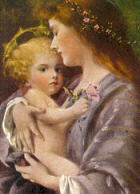
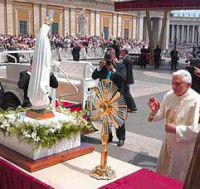 The pious practice of honoring Mary during the month of May has been especially recommended by the Popes. Pius XII made frequent reference to it and in his great Encyclical on the Sacred Liturgy (
The pious practice of honoring Mary during the month of May has been especially recommended by the Popes. Pius XII made frequent reference to it and in his great Encyclical on the Sacred Liturgy (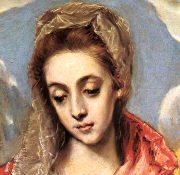 The Blessed Virgin Mary is the Mother of the Church and therefore the example, as well as the guide and inspiration, of everyone who, in and through the Church, seeks to be the servant of God and man and the obedient agent of the promptings of the Holy Spirit.
The Blessed Virgin Mary is the Mother of the Church and therefore the example, as well as the guide and inspiration, of everyone who, in and through the Church, seeks to be the servant of God and man and the obedient agent of the promptings of the Holy Spirit.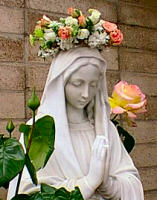 In our observance of the Marian month we should take into account the season of the Liturgical Year which largely corresponds with the fifty days of Easter. Our pious exercises could emphasize Our Lady's participation in the Paschal mystery and in Pentecost with which the Church begins. The pious exercises connected with the month of May can easily highlight the earthly role played by the glorified Queen of Heaven, here and now, in the celebration of the Sacraments of Baptism, Confirmation and Holy Eucharist.
In our observance of the Marian month we should take into account the season of the Liturgical Year which largely corresponds with the fifty days of Easter. Our pious exercises could emphasize Our Lady's participation in the Paschal mystery and in Pentecost with which the Church begins. The pious exercises connected with the month of May can easily highlight the earthly role played by the glorified Queen of Heaven, here and now, in the celebration of the Sacraments of Baptism, Confirmation and Holy Eucharist. 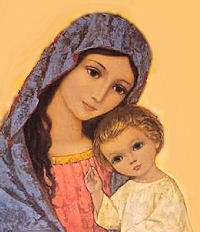



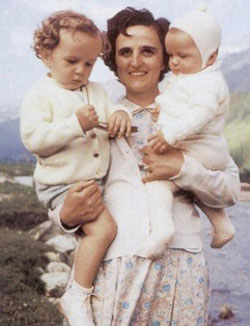 St. Gianna Beretta Molla
St. Gianna Beretta Molla
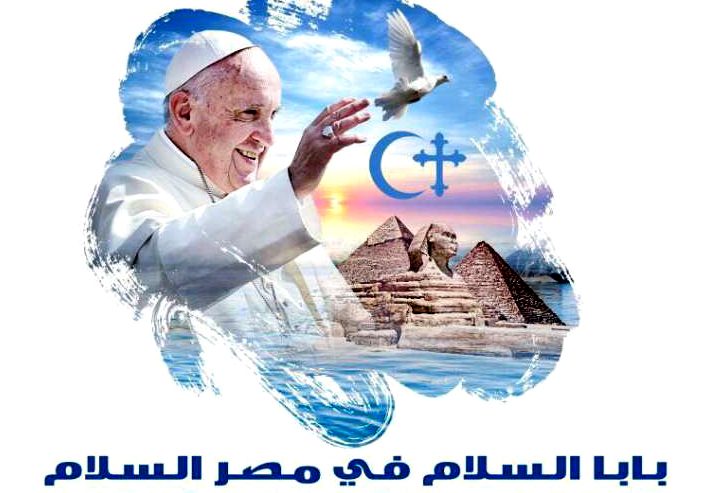
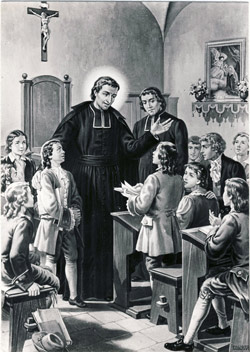 St Louis de Montfort
St Louis de Montfort 

